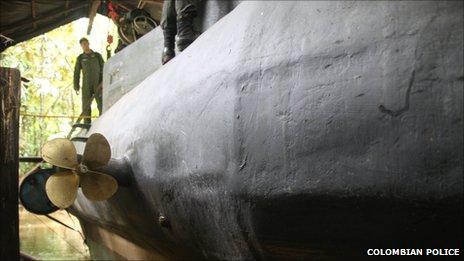Colombians seize $2m Farc drug submarine
- Published

The submarine was kept in a simple workshop deep in the Colombian jungle
Colombian anti-drugs police have seized a submarine built to smuggle cocaine - the second such find in two days.
Police said the submarine, worth about $2m (£1.2m), could stay under water for up to 10 days.
They said it would have been possible for a crew of up to five people to travel from Colombia to Central America and back without being detected.
The vessel was found in a jungle area in western Choco province after police received a tip-off from an informant.
Officers had to travel by helicopter to the dense jungle area near the Pacific coast.
Advanced technology
Deputy Head of Counter-narcotics Police Col Carlos Enrique Rodriguez Gonzalez told the BBC that what his men found there was a lot more advanced than they had expected.
"The submarine can travel up to 5m (16.5ft) below water and stay underwater for up to 10 days, making it possible to transport the drugs to Central America and travel back without being detected," he said.
He said while the submarine itself was not expensive to build, the sophisticated communications and navigational equipment and the radars it had on board made it worth around $2m.
The vessel, which had been hidden in a wooden shack, measures 12.2m in length, is 3.4m wide and 5m tall and is made of reinforced steel and covered in fibreglass.
It had the name Perla Negra (Black Pearl) painted on its side.
Col Rodriguez said it belonged to Colombia's largest left-wing rebel group, the Farc, who finance themselves largely through drug trafficking.
He said police investigations had revealed it was built on the orders of Jorge Neftali Umenza Velasco, also known as Mincho, who is accused of leading the 30th front of the Farc.
It was the second strike by the counter-narcotics police against the Farc's drug trafficking infrastructure in as many days.
On Saturday, they seized a semi-submersible vessel which could carry up to 10 tonnes of cocaine.
Col Rodriguez said the submarine found in Choco was smaller, and could pack only about four tonnes of drugs.
But its advanced ventilation system made it possible for a crew of up to five people to stay under water for more than a week, making it extremely difficult to detect.
- Published25 September 2011
- Published27 April 2011
- Published15 February 2011